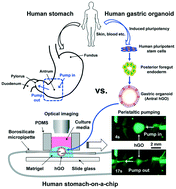Our official English website, www.x-mol.net, welcomes your
feedback! (Note: you will need to create a separate account there.)
Human stomach-on-a-chip with luminal flow and peristaltic-like motility†
Lab on a Chip ( IF 6.1 ) Pub Date : 2018-09-14 00:00:00 , DOI: 10.1039/c8lc00910d Kang Kug Lee 1 , Heather A McCauley , Taylor R Broda , Matthew J Kofron , James M Wells , Christian I Hong
Lab on a Chip ( IF 6.1 ) Pub Date : 2018-09-14 00:00:00 , DOI: 10.1039/c8lc00910d Kang Kug Lee 1 , Heather A McCauley , Taylor R Broda , Matthew J Kofron , James M Wells , Christian I Hong
Affiliation

|
Current in vitro approaches and animal models have critical limitations for modeling human gastrointestinal diseases because they may not properly represent multicellular human primary tissues. Therefore, there is a need for model platforms that recapitulate human in vivo development, physiology, and disease processes to validate new therapeutics. One of the major steps toward this goal was the generation of three-dimensional (3D) human gastric organoids (hGOs) via the directed differentiation of human pluripotent stem cells (hPSCs). The normal functions and diseases of the stomach occur in the luminal epithelium, however accessing the epithelium on the inside of organoids is challenging. We sought to develop a bioengineered platform to introduce luminal flow through hGOs to better model in vivo gastric functions. Here, we report an innovative microfluidic imaging platform housing hGOs with peristaltic luminal flow in vitro. This human stomach-on-a-chip allows robust, long-term, 3D growth of hGOs with the capacity for luminal delivery via a peristaltic pump. Organoids were cannulated and medium containing fluorescent dextran was delivered through the lumen using a peristaltic pump. This system also allowed us to rhythmically introduce stretch and contraction to the organoid, reminiscent of gastric motility. Our platform has the potential for long-term delivery of nutrients or pharmacological agents into the gastric lumen in vitro for the study of human gastric physiology, disease modeling, and drug screening, among other possibilities.
中文翻译:

具有管腔流动和类蠕动运动的人体胃芯片†
目前的体外方法和动物模型对模拟人类胃肠道疾病有严重的局限性,因为它们可能无法正确代表多细胞人类初级组织。因此,需要能够概括人类体内发育、生理学和疾病过程的模型平台,以验证新疗法。实现这一目标的主要步骤之一是通过生成三维 (3D) 人胃类器官 (hGO)人多能干细胞 (hPSC) 的定向分化。胃的正常功能和疾病发生在管腔上皮细胞中,但是进入类器官内部的上皮细胞具有挑战性。我们试图开发一个生物工程平台,通过 hGO 引入管腔流动,以更好地模拟体内胃功能。在这里,我们报告了一种创新的微流体成像平台,该平台容纳了具有体外蠕动腔流的hGO。这种人体胃芯片允许 hGO 稳健、长期、3D 生长,并具有通过管腔输送的能力蠕动泵。有机体被插管,含有荧光葡聚糖的培养基使用蠕动泵通过管腔输送。该系统还允许我们有节奏地向类器官引入拉伸和收缩,让人联想到胃动力。我们的平台有可能在体外将营养物质或药物长期输送到胃腔中,用于研究人体胃生理学、疾病建模和药物筛选等。
更新日期:2018-09-14
中文翻译:

具有管腔流动和类蠕动运动的人体胃芯片†
目前的体外方法和动物模型对模拟人类胃肠道疾病有严重的局限性,因为它们可能无法正确代表多细胞人类初级组织。因此,需要能够概括人类体内发育、生理学和疾病过程的模型平台,以验证新疗法。实现这一目标的主要步骤之一是通过生成三维 (3D) 人胃类器官 (hGO)人多能干细胞 (hPSC) 的定向分化。胃的正常功能和疾病发生在管腔上皮细胞中,但是进入类器官内部的上皮细胞具有挑战性。我们试图开发一个生物工程平台,通过 hGO 引入管腔流动,以更好地模拟体内胃功能。在这里,我们报告了一种创新的微流体成像平台,该平台容纳了具有体外蠕动腔流的hGO。这种人体胃芯片允许 hGO 稳健、长期、3D 生长,并具有通过管腔输送的能力蠕动泵。有机体被插管,含有荧光葡聚糖的培养基使用蠕动泵通过管腔输送。该系统还允许我们有节奏地向类器官引入拉伸和收缩,让人联想到胃动力。我们的平台有可能在体外将营养物质或药物长期输送到胃腔中,用于研究人体胃生理学、疾病建模和药物筛选等。











































 京公网安备 11010802027423号
京公网安备 11010802027423号